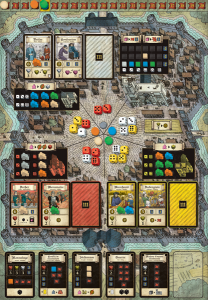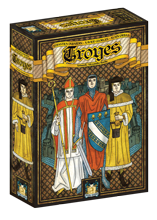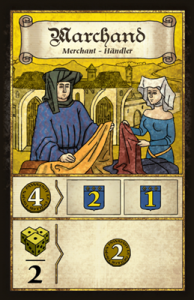Review: Troyes
Posted by James (admin) on November 3rd, 2010
 Troyes was in the top games on the Spiel Fairplay rankings throughout the show. Fortunately, I pre-ordered my copy as it sold out quickly.
Troyes was in the top games on the Spiel Fairplay rankings throughout the show. Fortunately, I pre-ordered my copy as it sold out quickly.
Troyes is a mixture of worker placement and dice allocation. The goal is to earn the most victory points (VPs). Players start with a few workers and one use for these is to place them in one of the 3 principal buildings: town hall (yellow), palace (red) and bishopric (white). At the start of each round, players receive 1 coloured dice for each of their workers in these buildings (yellow dice for workers in the yellow building, etc). Players roll their dice and place them in their area of the town square.
Before the main actions, 2 event cards are drawn which threaten the city and cause negative effects (like a loss of cash). The first player (and maybe players after them if required) will need to discard dice to combat the immediate effects although this doesn’t remove the events from the board.
Players then take turns using dice to execute actions. Using your own dice is always free but players can also use other players’ dice by paying the owner. The cost depends upon the total of dice being used (including their own): When using 1 dice it costs 2 cash, when using 2 dice they cost 4 each, when using 3 dice they cost 6 each. As well as buying dice, players can spend influence points to manipulate their own dice (1 point to re-roll a dice and 4 points to flip up to 3 dice to their opposite side); however, influence can not be used to alter dice bought from other players.
Players then take turns using dice to carry out actions. One action is to use 1 dice to place a worker in a principal building that matches the dice’s colour. The 6 locations in each building have values so the number on the dice determines where the new worker will get placed (which in turn determines which worker already in the building will be forced out).
The main action is to use one of the 9 activity cards. To use an activity, the player must have a worker already on the card, or must pay the marked price in cash to place one (extra workers cost 2 influence points). The first 2 workers on each card will score VPs at the end of the game too. With a worker in place, the player can use their selected dice (usually up to 3 dice) to trigger the activity. The player divides the total value of the dice by the number marked on the card and the result is the number of times the player triggers the benefit of the card. It’s a refreshing mechanic but quite unusual so let me give you an example.
Let’s say the player uses 3 yellow dice (3, 4 & 6 = 13 total) to activate this. They pay 4 cash to place a worker (as they do not have one on the card already). The total result of 13 is divided by 2 (the bottom left number) so the card is activated 6 times. Each activation gives the player 2 cash (icon bottom right), so they gain 12 cash.
The example of an activity card above is very simple but the abilities of the activity cards are very varied. For example, cards can let you convert dice colours, buy VPs, take dice for free, generate cash based on workers in principal buildings, etc.
Other actions allow the player to eliminate the negative events added each round (and doing so earns influence and VPs). Also, players can build the cathedral (dice results determine where a player places cubes of their colour on the cathedral) which gives an immediate VP and influence gain. There are 3 rows for cubes and, at the end of the game, players lose 2VP for each row in which they do not have a presence.
Once used, dice are placed aside and a round ends when all the dice have been used, or when all players have passed. The game ends after a fixed number of rounds (based on the number of players). Each player has a secret objective too for which they will score VPs at the end of the game.
 Overall, Troyes is a really interesting game. It takes a round or so to really start to absorb the use of the dice, influence points and workers but it feels fresh and interesting. Each turn, there are lots of different actions that can be undertaken especially because the powers of the activities are very varied. Rather than all being available from the start, 3 activity cards get revealed in each of the first 3 rounds which allows players to build up their knowledge of the options available to them and also forces players to compete over them whilst they still only have a few workers.
Overall, Troyes is a really interesting game. It takes a round or so to really start to absorb the use of the dice, influence points and workers but it feels fresh and interesting. Each turn, there are lots of different actions that can be undertaken especially because the powers of the activities are very varied. Rather than all being available from the start, 3 activity cards get revealed in each of the first 3 rounds which allows players to build up their knowledge of the options available to them and also forces players to compete over them whilst they still only have a few workers.
I really enjoy working out what is the best action to take. Some activity cards give you instant payouts but some allow you to use their powers a number of times in later turns. These delayed actions can increase your dice values, convert them into other colours, and so on. So, there are lots opf combinations that can be created and finding synergy in these combinations can really allow you to generate big results. For example, I used an activity to let me change one white dice into 2 red dice of the same value and I then used those 2 red dice on a different activity card to deal with the event cards which earned me VPs and influence.
Whilst all 18 dice are always available every round (at the start anyway) because players can buy them from opponents, it’s always good to have dice in your own area as these cost nothing to use them. So, having workers in the principal buildings can be important (and can get competitive, especially when only a few dice are left which aren’t much use for any other activities).
Dice start to vanish quite quickly as players buy them and use them. This means that, whilst you can plan what you want to do on your turn, you often need to adapt your plans rapidly as the dice you had wanted to use get bought by players before you.
Secret objectives are interesting but I like that they’re not too overpowering as the maximum they can score is 6 VPs. The rules say you should try not to give away your secret objective’s goal, but it doesn’t seem too important as it’s a short game and often better to focus on your goals. It seems quite hard for players to block each other, although some secret objectives seem easier to block than others.
My only real criticism with Troyes is that the number of rounds in a game isn’t a multiple of the number of players; for example, a 4-player game lasts 6 turns. As players take turns being first player, it means that the players will not all be first player an equal number of times. Going first is quite an advantage because you have the pick of all the dice. The game balances this a bit with the events as these make the first player (and maybe others) use up dice before players start taking actions. However, this discarding of dice doesn’t hinder the first player more than they gain from going first. So, being first player more than other players seems like an advantage. (I’m going to ask Pearl Games about this point to get their opinion.)
Finding a good combination of cards is great, although it can feel almost unsportsman-like to keep using the same combo every round if it’s available. I started doing actions that weren’t quite as rewarding just for some variety and to try and open other possibilities. If a player finds a good combo, it is up to other players to try and deny them this advantage (although they will need to balance this with making their own gains).
Troyes offers a lot of variety in replay because there are more activity and event cards than you will use in a single game. In fact, there are 27 activity cards and you only use 9 in a game. As a result, there are loads of different mixtures of activities and events which shape the game.
In conclusion, I really like Troyes because it’s different and offers lots of tactical play. On most turns, there are lots of different ways you could play it, especially if you have cash to buy (and influence to manipulate) dice. Gamers who like more certainty in their long-term planning may not enjoy this game.
James.
[Players with 4 players]



April 6th, 2011 at 8:47 pm
Great review. I look forward to getting this game soon.